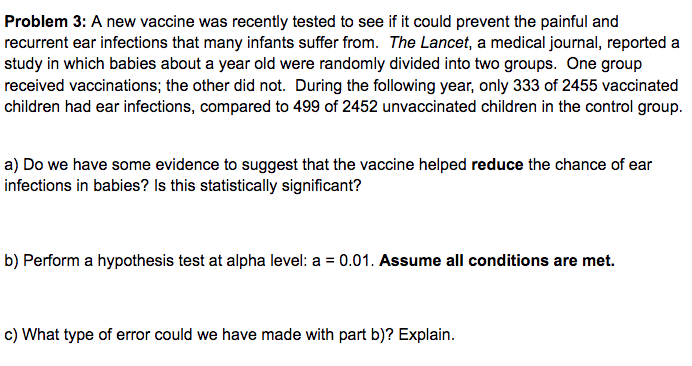Problem 3: A new vaccine was recently tested to see if it could prevent the painful and recurrent ear infections that many infants suffer from. The Lancet, a medical journal, reported a study in which babies about a year old were randomly divided into two groups. One group received vaccinations; the other did not. During the following year, only 333 of 2455 vaccinated children had ear infections, compared to 499 of 2452 unvaccinated children in the control group. a) Do we have some evidence to suggest that the vaccine helped reduce the chance of ear infections in babies? Is this statistically significant? b) Perform a hypothesis test at alpha level: a = 0.01. Assume all conditions are met. c) What type of error could we have made with part b)? Explain.
Addition Rule of Probability
It simply refers to the likelihood of an event taking place whenever the occurrence of an event is uncertain. The probability of a single event can be calculated by dividing the number of successful trials of that event by the total number of trials.
Expected Value
When a large number of trials are performed for any random variable ‘X’, the predicted result is most likely the mean of all the outcomes for the random variable and it is known as expected value also known as expectation. The expected value, also known as the expectation, is denoted by: E(X).
Probability Distributions
Understanding probability is necessary to know the probability distributions. In statistics, probability is how the uncertainty of an event is measured. This event can be anything. The most common examples include tossing a coin, rolling a die, or choosing a card. Each of these events has multiple possibilities. Every such possibility is measured with the help of probability. To be more precise, the probability is used for calculating the occurrence of events that may or may not happen. Probability does not give sure results. Unless the probability of any event is 1, the different outcomes may or may not happen in real life, regardless of how less or how more their probability is.
Basic Probability
The simple definition of probability it is a chance of the occurrence of an event. It is defined in numerical form and the probability value is between 0 to 1. The probability value 0 indicates that there is no chance of that event occurring and the probability value 1 indicates that the event will occur. Sum of the probability value must be 1. The probability value is never a negative number. If it happens, then recheck the calculation.
Can I get some help on problem 3 A-C

Trending now
This is a popular solution!
Step by step
Solved in 4 steps




